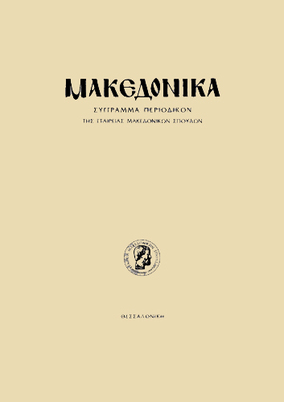Αποστολή Ιησουϊτών στη Μακεδονία το 17ο και 18ο αιώνα
Part of : Μακεδονικά ; Vol.27, 1989, pages 32-62
Issue:
Pages:
32-62
Parallel Title:
Jesuit Mission in Macedonia in the 17 C and 18 C
Section Title:
Articles
Abstract:
With its foundation in 1540 by the Spaniard Ignatius Loyola, the Society of Jesus (Societas Jesu), showed great interest for the Christian world of the East. The first contacts of its members, the Jesuits, with the Greeks go back in the last quarter of the 16 C.The Capitulations concluded in this period between France and the Sublime Porte thus allowing them to settle in Creta (1588) and Chios (1594). In the 17 C followed the foundations in Constantinople, Smyrne, Naxos, Euripos or Chalkis, Santorini and Tinos.During the first decades of the 17 C, the Jesuits of Constantinople began visiting Thrace and Macedonia, where stayed over some European tradesmen. The most profitable of those «flying missions» was the one of Father Isaac d’Aultry (1550-1) who had connections with the monks of Mount Athos and especially with those of Megisti Lavra.In 1706, Father François Braconnier settles down, with his Greek fel low member Father Mathieu-Xavier Piperis, in today’s Frankon street where the catholic church of the Virgin is, in the center of the town. Highly educated, an ardent archaeologist, Father Braconnier left behind an inte resting description of the region of Thessaloniki, Kavala, Thsasos and Mount Athos. Of this study I publish for the first time, in Greek translation some typical extracts.Shorter but no less interesting, is the narration of his successor Father François Tarillon (1716-26) regarding the missionary activities of his Order in Macedonia, which he calls «privileged region of Greece». Tarillon as well as Father Jean-Baptiste Souciet, in Thessaloniki from 1726 to 1738, believed that Macedonia and its capital Thessaloniki had a typical Greek character.The present study on the mission of the Jesuits in Northern Greece in the first third of the 17 C, closes with Father Souciet, whose description of the town of Thessaloniki in 1734, was presented to the readers in «Make- donika» (volume VIII, 1968) by A. Xanthopoulou-Kyriakou.Another article, on the activities of the Jesuits in Thessaloniki from 1738 to the abolition of their congregation by Pope Clement XIV in 1773, will be published in the next edition of «Makedonika». In this second part we will stress the educational work of the Jesuits, who excelled in this field. There will also be the subject of the founding of the Catholic Church in Frankon Street. Thus the readers of «Makedonika» will have an exact idea of the work accomplished by the Jesuits in Macedonia in the 18 C.
Subject:
Subject (LC):
Notes:
856:https://ejournals.epublishing.ekt.gr/index.php/makedonika/article/view/5653, DOI: https://doi.org/10.12681/makedonika.92
Electronic Resources:




